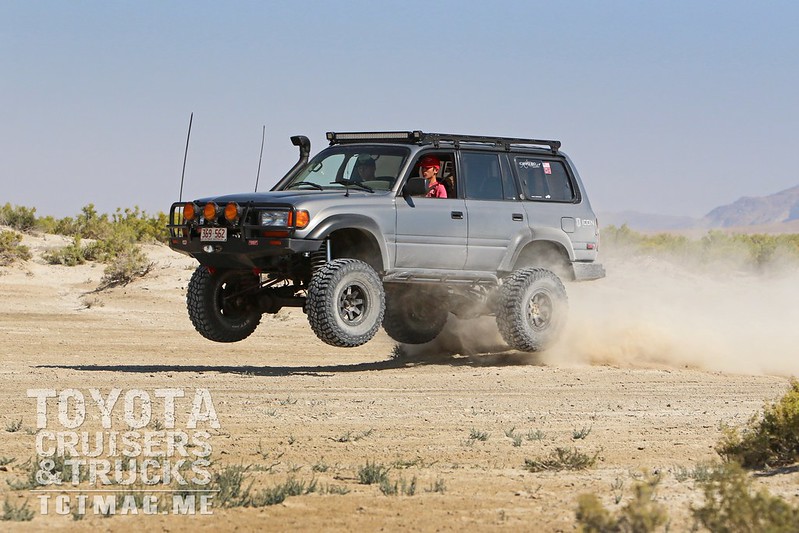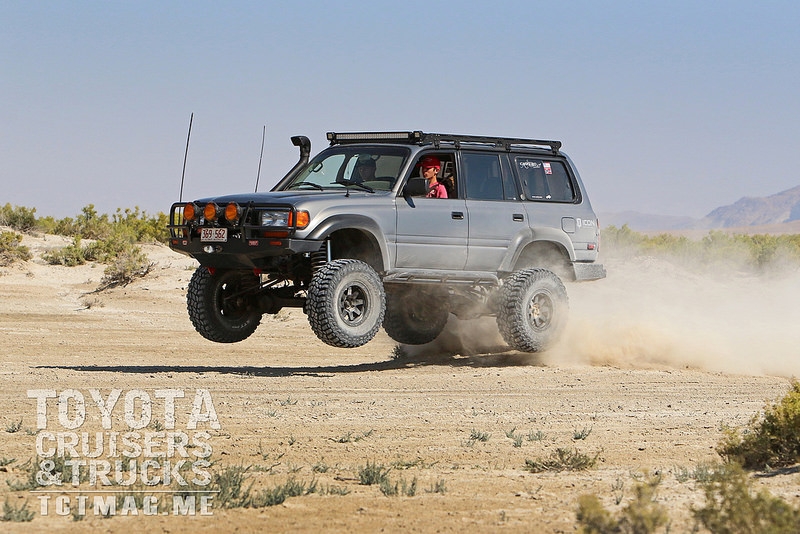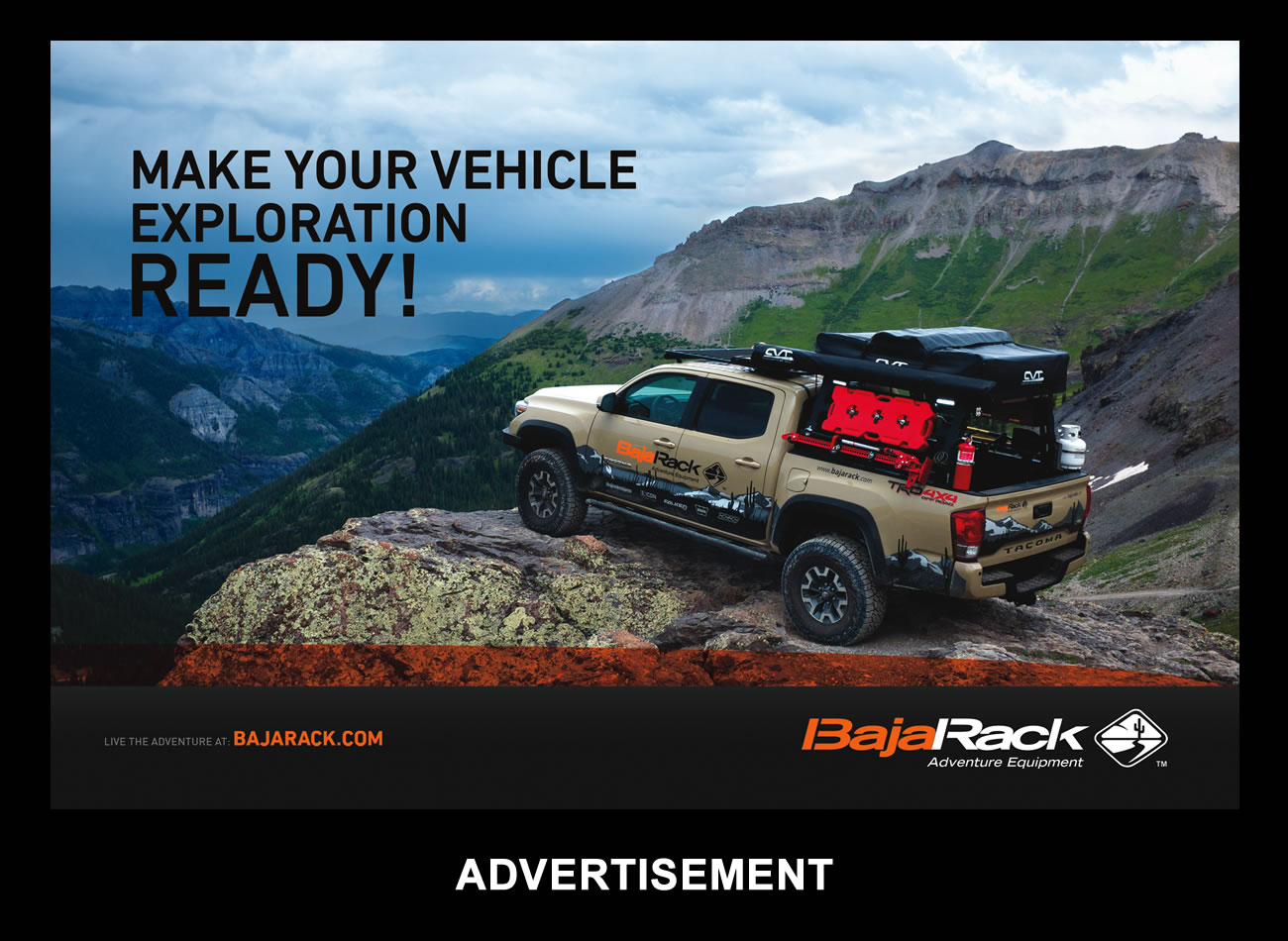
I was clipping along in my 80 series, at almost 70 mph through the sage and yucca, when cresting a rise I found myself nearly on top of the next big bump with no time to scrub speed. I got light in my seat. The truck left the ground briefly. There was now a long straight section of trail mostly obscured by desert grass. I mashed the throttle and the needle passed 70. Just as I felt confident to keep accelerating a deep, sharp ditch across the trail came into view through the grass. Again too late to drop speeds, I accelerated to try to get the truck to carry across the gap instead of hitting a low point. I prepped myself for a big hit. I was clipping along in my 80 series, at almost 70 mph through the sage and yucca, when cresting a rise I found myself nearly on top of the next big bump with no time to scrub speed. I got light in my seat. The truck left the ground briefly. There was now a long straight section of trail mostly obscured by desert grass. I mashed the throttle and the needle passed 70. Just as I felt confident to keep accelerating a deep, sharp ditch across the trail came into view through the grass. Again too late to drop speeds, I accelerated to try to get the truck to carry across the gap instead of hitting a low point. I prepped myself for a big hit.
As time slowed my mind considered all of the parts in the front end that were going to be broken. Bang! The distinct noise was not as bad as I expected. Even more shocking: other than the noise, the truck didn’t disintegrate. I slowed to a stop to check the damage. No bent steering. Control arms still straight. Nothing leaking. The suspension seemed to just grin at me, mockingly saying, "is that all you’ve got?"
A year earlier I had upgraded the suspension on my 80 to a new kit coming out of Australia. The Stage 1 Slinky Long Travel kit. I was intrigued by the tapered wire, dual rate coils, and the Australian spec ICON 2.0 shocks. Fast forward 12 months later and I had almost 20k miles on this suspension from daily driving, to 7-8,000 off-road miles of slow speed rock crawling and high speed desert running. If you want to find out what I thought about the Stage 1 Kit, take a look back at the Summer 2016 Issue of TCT Magazine and you’ll find my review. In sum, I believe the Slinky kits are the best all-around performance suspension available for the 80 series when considering bolt-on kits and not going full custom. A year earlier I had upgraded the suspension on my 80 to a new kit coming out of Australia. The Stage 1 Slinky Long Travel kit. I was intrigued by the tapered wire, dual rate coils, and the Australian spec ICON 2.0 shocks. Fast forward 12 months later and I had almost 20k miles on this suspension from daily driving, to 7-8,000 off-road miles of slow speed rock crawling and high speed desert running. If you want to find out what I thought about the Stage 1 Kit, take a look back at the Summer 2016 Issue of TCT Magazine and you’ll find my review. In sum, I believe the Slinky kits are the best all-around performance suspension available for the 80 series when considering bolt-on kits and not going full custom.
Back to the story that I started with... we were on our third day of a product testing trip. We had several hundred off-road miles from St. George to Moab, UT, with Darren McRae, of Autocraft the creator of the Slinky kits, and US distributor counterparts. We also had a handful of Slinky customers or prospective customers. Before the trip, we visited IH8MUD headquarters just outside of St. George to use Woody’s shop lift so I could upgrade my suspension yet again. This time I was stepping up from the Stage 1 to the Stage 4 shocks.
I want to focus on the differences and pros and cons to the different Slinky shock options. The Stage 1 shocks are an ICON 2.0 smooth body IFP shock that has been valved and tuned by Darren specifically for the 80 series. For those looking to get to another level of performance with their 80, but still need to fit in a budget, these Stage 1 2.0 shocks are the best smooth body shocks I’ve experienced in my 20 years of 80 series ownership.I want to focus on the differences and pros and cons to the different Slinky shock options. The Stage 1 shocks are an ICON 2.0 smooth body IFP shock that has been valved and tuned by Darren specifically for the 80 series. For those looking to get to another level of performance with their 80, but still need to fit in a budget, these Stage 1 2.0 shocks are the best smooth body shocks I’ve experienced in my 20 years of 80 series ownership.
In contrast, the Stage 4 ICON shocks are a 2.5 remote reservoir (front) and a 2.5 piggy back reservoir (rear) that, when combined with the Slinky Long Travel coils, create the triple threat setup. A number of things make the Stage 4 shocks unique and different from the Stage 1’s. First, it starts with a ͞flutter stack͟ in the valving to allow some movement of the shock shaft before full valving sets in. This provides a supple ride with a higher fast piston speed valving code. Think of corrugated roads when you haven’t aired down your tires from 45psi, no fun right? Not anymore. With the Slinky shocks, washboard roads now feel smooth and you wonder where that buzzing noise from the bumps is coming from.
Second, the Stage 4 shocks have adjustable Compression Dampening Control (͞CDC͟). The CDC secondary piston and valve stack stops the pintle style, restrictive ͞90 psi in the tires͟ feeling on sharp bumps when road driving and are typically less than half the line pressure of other adjustable shocks at fast piston speeds. There are 8 different adjustability settings. Changing the setting is a simple turn of a dial. Stage 1 shocks are the equivalent of a setting of 4 on the Stage 4 CDC adjustment dial.No tools are needed, so it’s easy to make changes and dial in your ride for different conditions or vehicle loads in a matter of seconds. Second, the Stage 4 shocks have adjustable Compression Dampening Control (͞CDC͟). The CDC secondary piston and valve stack stops the pintle style, restrictive ͞90 psi in the tires͟ feeling on sharp bumps when road driving and are typically less than half the line pressure of other adjustable shocks at fast piston speeds. There are 8 different adjustability settings. Changing the setting is a simple turn of a dial. Stage 1 shocks are the equivalent of a setting of 4 on the Stage 4 CDC adjustment dial.No tools are needed, so it’s easy to make changes and dial in your ride for different conditions or vehicle loads in a matter of seconds.
Third, the Stage 4 Slinky shocks have a built in hydro bump zone at fast piston speed for when the piston goes past the top manifold. What does all this mean for the average dude that isn’t a suspension engineer? It means a dramatic increase in vehicle control and comfort not only on the road but in rough terrain. Both kits are available either in 50mm or 75mm lift heights with intermediate or heavy coil spring rates. The shocks are a full 12͟ of travel, and the coils have a taller free height to stay seated in the coil buckets even at the limit of flex. There is a full compliment of supporting components like adjustable track bars (panhards) and heavy duty rear lower control arms and adjustable upper control arms, along with brake lines and caster correction options to get everything set up correctly.
Related Articles
During the course of our testing trip we had vehicles with Stage 1 Slinky suspension, Stage 4 Slinky suspension, and without Slinky suspension. We needed to cover a lot of miles in a short few days in order to get to Cruise Moab on time. We travelled fast. The vehicles that were not Slinky equipped were unable to keep pace with the other trucks. In trying to keep up, all non-Slinky equipped trucks had varying degrees of shock fade, with some having total shock failure. This slowed them down even more as there was essentially no suspension dampening at all until the shocks cooled. With the Slinky Stage 4 shocks, and piggy back and remote reservoirs there is enough oil in the shocks that it is virtually impossible to run them hard enough for a long enough amount of time to create any shock fade. So, long off-road trips like this at high speeds are no big deal. Not only is the truck less fatigued, but you as the driver are less fatigued after a long day on the trail.
The excellent valving and adjustability of the Stage 4 shocks provides an entirely new level of confidence when driving an 80 series at higher speeds on rough terrain. I stopped even thinking about rocks any smaller than a basketball in the trail. The shocks just soaked them up. Catching some air off that crest? No problem. If you own an 80 series you know that they are heavy trucks right off the lot. When built up with bumpers, winches, bigger tires, roof racks, rooftop tents, fridges, drawers and all the camping gear you bring along for days on the trail exploring and camping, they get significantly heavier.When you start to push speeds in an built 80 the truck will lean and wallow through corners. It can be unnerving to say the least.You also find your bump stops regularly when travelling fast. That is just not the case with the Slinky suspension. The excellent valving and adjustability of the Stage 4 shocks provides an entirely new level of confidence when driving an 80 series at higher speeds on rough terrain. I stopped even thinking about rocks any smaller than a basketball in the trail. The shocks just soaked them up. Catching some air off that crest? No problem. If you own an 80 series you know that they are heavy trucks right off the lot. When built up with bumpers, winches, bigger tires, roof racks, rooftop tents, fridges, drawers and all the camping gear you bring along for days on the trail exploring and camping, they get significantly heavier.When you start to push speeds in an built 80 the truck will lean and wallow through corners. It can be unnerving to say the least.You also find your bump stops regularly when travelling fast. That is just not the case with the Slinky suspension.
With my truck fully loaded and carrying one of the heavier roof tents on the market I was comfortably and confidently driving speeds in the dirt that far exceeded any speeds I would have ever attempted, even with an empty truck prior to having the Slinky suspension. It would have been quite nerve-wracking to drive like that with other commonly used suspensions.
In conclusion. I spent a year with the Stage 1 shocks and was very happy with them. The limitations of the Stage 1 shocks become evident at higher speeds. I would occasionally ͞overrun͟ the Stage 1 shocks and bottom out through big bumps. The Stage 1 shocks are fantastic for relatively lightweight 80s that aren’t burdened by lots of extra weight from modifications and gear. But if you’re 80 has more than say a front bumper, a winch and some sliders you may want to consider stepping up to the Stage 4’s.They will handle the weight and give you the ability to make adjustments for when your truck is unloaded for daily driving or when it’s fully stacked for that two week trip down the Baja peninsula. They will give you the confidence to know that when you run out of talent like I did in the story I began this article with, the suspension will soak up your mistakes, whether it’s a smooth landing or surprise hole in the trail.There is serious technology and engineering behind the Slinky suspension systems. It was developed specifically for the 80 series. These kits have been tested and proven in Australia for years and it’s exciting to have these kits as an option for us here in the US. In conclusion. I spent a year with the Stage 1 shocks and was very happy with them. The limitations of the Stage 1 shocks become evident at higher speeds. I would occasionally ͞overrun͟ the Stage 1 shocks and bottom out through big bumps. The Stage 1 shocks are fantastic for relatively lightweight 80s that aren’t burdened by lots of extra weight from modifications and gear. But if you’re 80 has more than say a front bumper, a winch and some sliders you may want to consider stepping up to the Stage 4’s.They will handle the weight and give you the ability to make adjustments for when your truck is unloaded for daily driving or when it’s fully stacked for that two week trip down the Baja peninsula. They will give you the confidence to know that when you run out of talent like I did in the story I began this article with, the suspension will soak up your mistakes, whether it’s a smooth landing or surprise hole in the trail.There is serious technology and engineering behind the Slinky suspension systems. It was developed specifically for the 80 series. These kits have been tested and proven in Australia for years and it’s exciting to have these kits as an option for us here in the US.
If you are looking for top tier suspension performance for your Cruiser, I think this just might be the best.Slinky kits are currently available through Redline Land Cruisers and other US dealers are coming soon.
[flickr set=72157688262418244]
To get your copy of theSummer 2017 Issue: |









